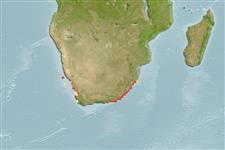Environment: milieu / climate zone / depth range / distribution range
Ecologie
marien; brak water demersaal; diepte 10 - ? m. Subtropical; 28°S - 34°S
Southeast Atlantic: Mossel Bay to Natal in South Africa.
Lengte bij maturiteit / Grootte / Gewicht / Leeftijd
Maturity: Lm 57.5 range ? - 70 cm
Max length : 200 cm TL mannelijk / geslacht onbekend; (Ref. 3198); common length : 100.0 cm TL mannelijk / geslacht onbekend; (Ref. 3507); max. gepubliceerd gewicht: 80.0 kg (Ref. 4537)
Dorsale stekels (totaal): 11; Dorsale zachte stralen (totaal): 10-11; Anale stekels 3; Anale zachte stralen: 8. Reddish, bronzy or golden-yellow in color; young with a blotch behind dorsal fin.
Found near rocky banks in coastal waters including estuaries. Adults solitary and territorial. Feeds on octopus, crabs and fish, especially Spondyliosoma. The flesh is highly esteemed, but the liver is poisonous due to high vitamin A content which causes hypervitaminosis. Popular angling fish. Largest of the porgies.
Levenscyclus en paargedrag
Maturiteit | Voortplanting | Paaien | Eieren | Fecunditeit | Larven
Smith, J.L.B. and M.M. Smith, 1986. Sparidae. p. 580-594. In M.M. Smith and P.C. Heemstra (eds.) Smiths' sea fishes. Springer-Verlag, Berlin. (Ref. 3198)
Status op de Rode Lijst van het IUCN (Ref. 130435)
Gevaar voor de mens
Poisonous to eat (Ref. 3507)
Gebruik door de mens
Visserij: van minder commercieel belang; sportvis: ja
Meer informatie
ReferentiesAquacultuurAquacultuurprofielKweeklijnenGeneticaElectrophoresesErfelijkheidZiektesVerwerkingNutrientsMassaconversie
Tools
Speciale rapporten
Download XML
Internetbronnen
Estimates based on models
Preferred temperature (Ref.
123201): 15 - 24, mean 22.2 °C (based on 10 cells).
Fylogenetische diversiteitsindex (Ref.
82804): PD
50 = 1.0000 [Uniqueness, from 0.5 = low to 2.0 = high].
Bayesian length-weight: a=0.01549 (0.00889 - 0.02698), b=3.04 (2.89 - 3.19), in cm total length, based on LWR estimates for this species & (Sub)family-body (Ref.
93245).
Trofisch niveau (Ref.
69278): 4.5 ±0.61 se; based on food items.
Generation time: 14.6 ( na - na) years. Estimated as median ln(3)/K based on 2
growth studies.
Weerstandsvermogen (Ref.
120179): laag, minimale populatieverdubbelingstijd 4,5-14 jaar (K=0.08; tm=5-7; tmax=30;).
Fishing Vulnerability (Ref.
59153): Very high vulnerability (80 of 100).
Climate Vulnerability (Ref.
125649): Very high vulnerability (92 of 100).
Nutrients (Ref.
124155): Calcium = 29 [17, 56] mg/100g; Iron = 0.833 [0.448, 1.585] mg/100g; Protein = 20.2 [19.2, 21.3] %; Omega3 = 0.36 [0.22, 0.60] g/100g; Selenium = 37.5 [16.0, 74.5] μg/100g; VitaminA = 9.94 [2.73, 33.75] μg/100g; Zinc = 0.486 [0.332, 0.711] mg/100g (wet weight);
